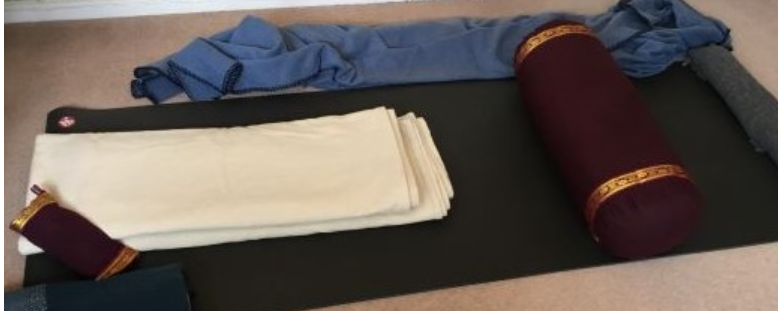Getting comfortable in Savasana
How do you practise Savasana? How long do you usually stay in this Restorative yoga pose? And do you take the time to ensure that when you do lie down in Savasana you’re going to be as comfortable as possible?
For many people Savasana is relegated to a couple of minutes at the end of a dynamic yoga practice. It may be viewed as a bit of a waste of time: time which could have been spent on a few more downward facing dogs or an extra sun salutation or two. Or maybe you think of it as just a short ‘nap’ at the end of your yoga session.
It can be the most challenging pose of all. It requires us to do something we rarely do in our busy, chronically stressed daily lives: to lie down and do absolutely nothing. To simply be.
And if you’re fidgeting and distracted because you’re uncomfortable, you’re never going to experience the benefits that Savasana has to offer.
When you lie down in Savasana you need to ensure that the body is supported in a position of comfort and ease so as to facilitate the ‘relaxation response’. For most people that means using some props. So it’s worth getting to know what your body needs each time you practise Savasana.
In terms of how long to stay in the pose, my Restorative yoga teacher, Judith Hanson Lasater suggests you stay 20 minutes or more. That way, you’re more likely to benefit from a taste of the ‘relaxation response’, when the nervous system is manipulated into parasympathetic dominance allowing you rest fully.
When we are always on the go, juggling the responsibilities of job and family, coping with health and financial worries, it’s almost inevitable that we will feel the effects of chronic stress. When we’re chronically stressed, we experience muscle tension, headaches, impatience, irritation, anger, frustration, anxiety and we risk making ourselves ill.
But by making sure we regularly rest deeply, we can begin to target the effects of chronic stress and boost our immune system.
And, in these challenging times, it’s more important than ever that we ensure we get the rest we need.
One of my favourite ways to practise Savasana, is to set up for what’s sometimes called ‘Pranayama Savasana’, where the back body is supported by staggered blankets at an angle which can be helpful in keeping the spine supported and the lungs open.
Fold two blankets and place one on top of the other so that there is about a 4 to 6 inch gap between them. Have a bolster, another rolled blanket, an eye pillow and a blanket to cover up handy.
Fold the top edge of one (or both) blankets under, maybe bringing the top blanket all the way down to the tops of your shoulders. When you lie back, your pelvis should be touching the bottom blanket and you want to make sure your head and neck are comfortable and that your forehead is slightly higher than your chin.
Sit up, place the rolled blanket under your Achilles tendons so your heels float up and use a bolster to support the back of your knees. Place a blanket over you and, as you lie back, an eye pillow to cover the eyes. Set a timer for 20 minutes or more and allow yourself to rest on an ocean of stillness.
Enjoy!


